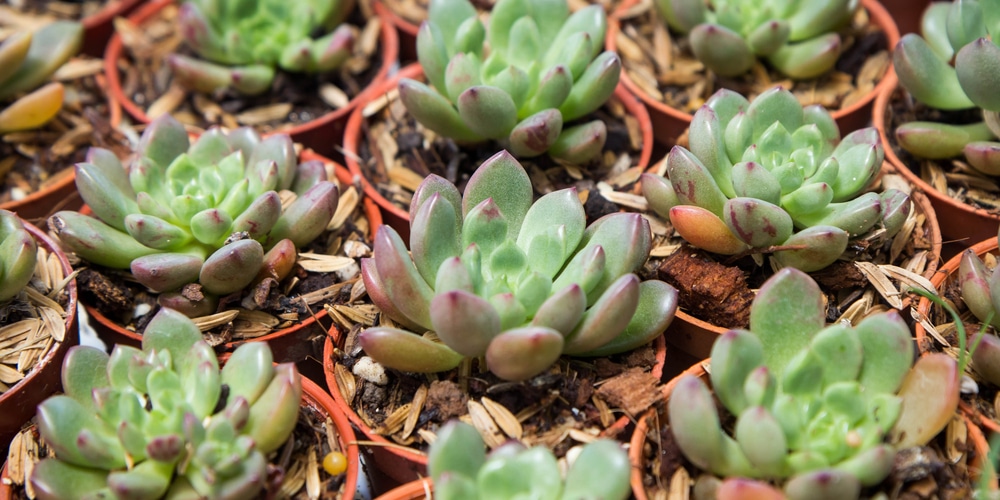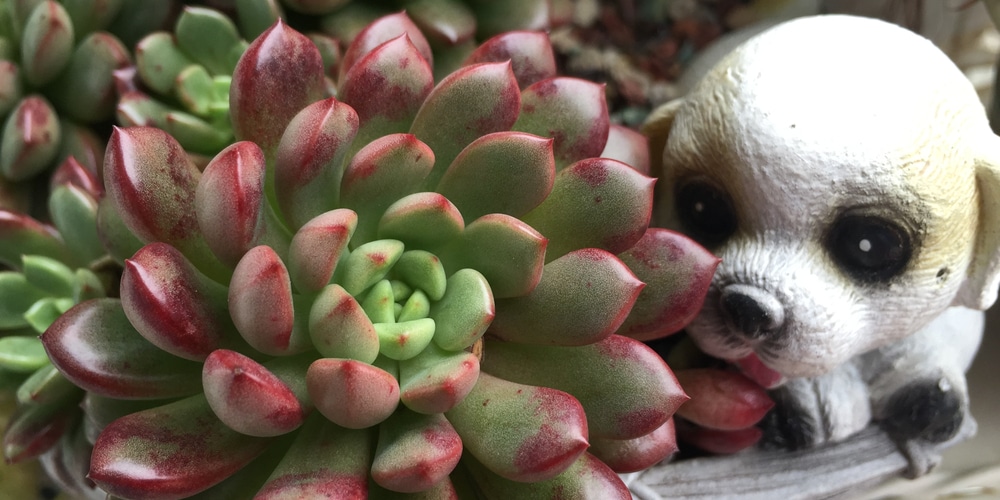Hybrids are all the rage in the succulent world and Graptoveria ‘Bashful’ is no exception. This lovely succulent plant has rosette-forming leaves, with no stems.
It is a cross between Echeveria and Graptopetalum, two well-known genera in the succulent world. The leaves are thick and fleshy, with a powdery coating that helps the plant retain water in hot, dry conditions.
While these succulents bloom pretty pink or white flowers, they are grown not for their blooms, but for their stunning display of colors and texture.
Similar to other Graptoveria, its leaves form a beautiful rosette pattern that hugs the ground. The colors are what make this plant so special, with its purple tones on the leaves that turn pink in brighter light.

| Botanical Name | Graptopetalum x Echeveria / Graptoveria Bashful |
| Common Name | Rosy Cheeks |
| Plant Type | Perennial |
| Flower Color | White / Yellow |
| Size When Mature | 5 inches tall |
| Bloom Time | Early to Mid Summer |
| Sun Requirements | Full to Partial Sun |
| USDA Hardiness Zones | 10 – 11 |
| Soil PH Range | 6.0 – 7.0 |
| Soil Type | Porous, gritty, well-draining soil |
| Water Needs | Medium |
| Native Area | Hybrid, not found in nature |
What You Need to Know About Graptoveria Bashful
If you’re wondering what to get next for your succulent collection, the Graptoveria Bashful, also referred to as Rosy Cheeks make up for an excellent choice. These sun-loving plants have leaves forming in a rosette pattern and boast of a range of colors, turning from purple to shades of pink as they get more sunlight.
Its fleshy leaves are what give the plant the ability to store water, allowing it to survive in hot and dry conditions. The powdery coating on the leaves also helps with this by reducing evaporation.
Without a doubt, this beautiful succulent makes a beautiful impression when placed on any container. Perfect for desktops, window sills, coffee tables, or any other small space in your home. Graptoveria ‘Bashful’ is a relatively easy plant to care for, provided you give it the right conditions.
How to Care for Graptoveria Bashful
Here’s everything you need to know about growing and caring for a thriving Graptoveria Bashful:
Light
This tiny but mighty succulent can withstand extreme temperatures and love the sun. Its beautiful colors are only intensified when exposed to more sunlight. However, if you live in an area with intense summer heat, moving it for a bit of shade during the hottest days is ideal.
In winter, the plant will appreciate some bright light but can tolerate lower light levels. A south-facing windowsill serves as the perfect spot during these months.
Water and Soil Needs
Although they are drought-tolerant, like all succulents, Graptoveria Bashful prefers not to be kept too dry. When the weather is hot and dry, water it about once a week. Give it a good soak and wait for the soil to completely dry out before watering once more.
Ideally, a succulent potting mix with perlite or pumice added for drainage is ideal. If you don’t have a succulent potting mix on hand, feel free to make your own by mixing together two parts coarse sand, and one part regular potting soil. It prefers porous soil that drains quickly.
Temperature Requirements
This plant is quite tolerant to a range of temperatures, both hot and cold. In fact, it can survive in temperatures as low as 20 degrees Fahrenheit. However, it’s best to keep it above freezing if possible.
When it comes to humidity, this tough little plant can tolerate dry conditions but will do best in average to high humidity. Hardy in USDA hardiness zones 10 to 11, this succulent grows best outdoors, with dappled and/or or filtered sunlight.
Fertilizer
Although not necessary, you can give your Graptoveria Bashful a light succulent fertilizer during the spring and summer months to encourage growth. Use a succulent fertilizer or a water-soluble all-purpose fertilizer diluted at half-strength.
Common Diseases
One of the best things about this plant is that it’s relatively disease and pest free. However, like all succulents, it can be susceptible to root rot if overwatered. If you see the leaves start to wilt or turn mushy, you have to stop overwatering immediately. Root rot is often hard to treat and can quickly kill your plant so it’s best to be proactive.
Pests are also not usually a problem with this plant. However, if you do notice any pests, as soon as you first see the first signs, immediately get rid of them by hand.
Graptoveria Bashful Propagation
If you want to give these out to friends or family or just have more of these pretty succulents, propagation is relatively easy. The best time to propagate is in the spring and summer. Choose from its offsets or leaves, but either way, make sure the plant is healthy.
To propagate from offsets, carefully remove them from the mother plant with a sharp knife. Don’t plant it just yet. There’s a process called callusing that you must do first.
This helps the plant heal its wound and prevents infection. Place the offsets on a dry surface and let them sit for a few days. You’ll know it’s ready when you start seeing a white callus forming on the cut surface.
Once the callusing process is complete, it’s time to plant. Use a well-draining succulent potting mix and place the offsets on top. Gently press down so that the mix makes full contact with the offset. Water lightly and place in an area with bright, indirect light.
When choosing from leaves, use the same process above, just cutting a healthy leaf instead. It’ll take a bit longer for roots to form but with proper care, you’ll have a new plant in no time.
Related Article: Why is My Succulent Turning Red?

